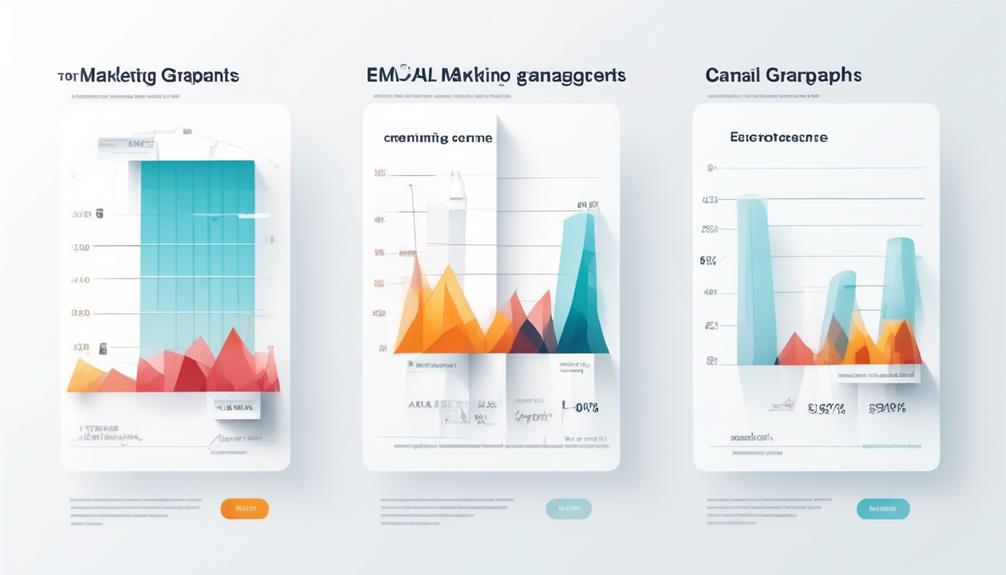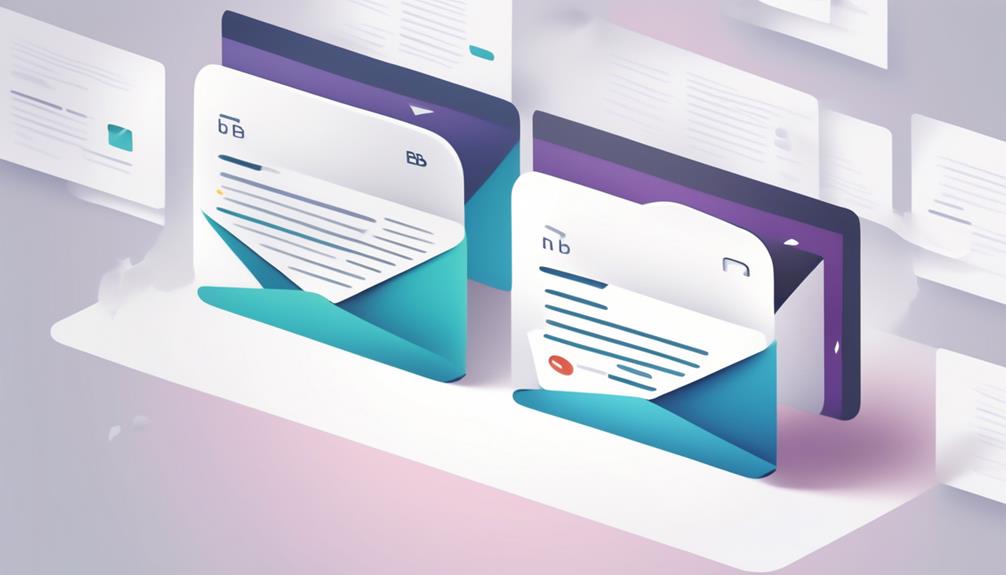In the world of email marketing, discovering successful tactics to boost engagement can make a big difference. We’ve all come across emails with subject lines that either grab our interest or make us scroll past. So, the question is, how can we ensure that our emails are considered engaging?
A/B testing offers a way to systematically analyze and optimize different elements of our emails, but there's more to it than just changing a few words here and there. By uncovering the nuances of A/B testing tactics for emails, we can unlock the potential to truly connect with our audience and drive meaningful results.
Key Takeaways
- A/B testing in email marketing is crucial for optimizing open rates, click-through rates, traffic, conversions, and decreasing unsubscribe rates.
- Neglecting A/B testing can have detrimental effects on email deliverability and readability.
- A/B testing helps identify effective subject lines and content for improved engagement.
- Utilizing A/B testing tools and analyzing test results enable marketers to make data-driven decisions and optimize campaign performance.
The Importance of A/B Testing in Email Marketing
Understanding the significance of A/B testing in email marketing entails uncovering valuable insights that drive improved campaign performance and audience engagement. A/B testing isn't just about randomly trying different versions of emails; it's a strategic approach to optimize open rates, click-through rates, traffic, conversions, and decrease unsubscribe rates.
Neglecting A/B testing can have detrimental effects on email deliverability and readability, which are crucial for the success of email marketing campaigns. By experimenting with different subject lines, content, and design elements, A/B testing enables marketers to gain a deeper understanding of audience preferences and behavior, leading to data-driven decisions for improved email marketing strategies.
A/B testing helps in identifying the most effective subject lines that prompt recipients to open emails, as well as the content that resonates better with the audience, resulting in improved engagement. It allows marketers to fine-tune their emails for better performance, ultimately enhancing the overall effectiveness of email marketing campaigns.
The insights gained from A/B testing empower marketers to create more targeted and impactful content, thereby maximizing the potential of email marketing efforts.
Key Variables for Email A/B Testing

When it comes to A/B testing for email marketing, subject line testing is crucial for maximizing open rates. By experimenting with different lengths, personalization, and the use of emojis, we can determine what resonates best with our audience.
Additionally, varying the types of offers, discounts, and call-to-action placements and designs can significantly impact click-through rates, making it another key variable worth testing.
Subject Line Testing
Subject line testing is a critical component of A/B testing for emails. It allows marketers to analyze the resonance of different variables such as length, personalization, and the use of emojis with their audience.
The subject line is the first thing recipients see, making it crucial for driving Email Open rates. Testing different subject lines provides insights into what might work best for engaging recipients.
Marketers can experiment with different copy, length, and personalization to see which one resonates most with their audience. Emojis can also be tested to gauge their impact on Email Open rates.
Call-To-Action Variation
Call-To-Action Variation in A/B testing for emails builds on the critical insights gained from subject line testing, allowing marketers to analyze the effectiveness of different CTAs, offers, and placements in driving recipient engagement and conversion rates.
By testing your email campaigns, you can optimize the CTA button, offer types, and their placements to improve open rates and click-through rates. Experiment with various CTAs to understand which resonates best with your audience.
Additionally, testing different offers, such as discounts, free trials, or limited-time promotions, provides valuable insights into what motivates recipients to act.
Furthermore, varying the design and placement of CTAs within the email content can significantly impact conversion rates.
Utilizing A/B testing to assess call-to-action variations is crucial for refining email marketing strategies and maximizing campaign performance.
Best Practices for A/B Testing Emails
When it comes to A/B testing emails, subject line testing and content variation testing are two critical best practices to consider.
By experimenting with different subject lines, we can determine which ones resonate best with our audience and drive higher open rates.
Similarly, testing variations in content allows us to identify the most engaging and compelling messaging that leads to increased click-through rates.
These best practices enable us to make informed decisions that optimize email campaign performance.
Subject Line Testing
Experimenting with different variations of subject lines is a critical component of optimizing email open rates through A/B testing tactics. When it comes to subject line testing, several key factors should be considered to ensure the most effective approach:
- Subject Line Length: Testing different lengths can help determine the optimal size for engaging recipients without getting cut off.
- Personalization: Evaluating the impact of personalized subject lines compared to generic ones can provide insights into audience preferences.
- Emojis and Symbols: Testing the use of emojis and symbols in subject lines can reveal whether these elements positively influence open rates.
- Clear Call-to-Action: Experimenting with different CTAs in subject lines can help identify which ones resonate best with the audience, driving higher open rates.
Content Variation Testing
Content Variation Testing in email marketing is a crucial strategy for optimizing campaign performance and engaging recipients effectively. By experimenting with different elements of email content, marketers can identify what resonates best with their audience. A variety of variables, including subject lines, offers, design, timing, personalization, and segmentation, can be tested through A/B testing to enhance email performance. Here's a data-driven approach to content variation testing:
| Variable | Impact on Engagement Rates |
|---|---|
| Subject Line Length | Shorter often performs better |
| Send Time | Varies based on target audience |
| Testing Offers | Tailoring offers improves conversion |
| Email Performance | Monitoring open and click-through rates |
| Email Design | Clean and visually appealing design leads to better engagement |
These insights can help marketing agencies fine-tune their email strategies, resulting in improved engagement and conversion rates.
Utilizing A/B Testing Tools

To effectively utilize A/B testing tools for email marketing, it's essential to harness the power of data-driven insights to optimize campaign performance. Here are some best practices for utilizing A/B testing tools effectively:
- Choose the Right Tool: Select an A/B testing tool that integrates seamlessly with your email marketing platform and provides robust analytics to measure open rates, click-through rates, and other key metrics.
- Test Different Elements: Experiment with variations in the subject line, sender name, and content of the emails to understand what resonates best with your audience.
- Analyze Test Results: Carefully analyze the A/B test results to identify patterns and trends that can inform future email marketing strategies. Look for insights into what drives higher open rates, click-through rates, and conversions.
- Refine Email List Segmentation: Utilize A/B test results to segment your email list based on user preferences and behaviors, allowing for more targeted and personalized email campaigns.
Tips for Setting Up A/B Email Tests

When setting up A/B email tests, it's crucial to define clear improvement goals for your marketing emails. This involves identifying specific elements of your emails that you aim to test and improve, such as the open rate, click-through rate, or conversion rate.
By focusing on frequently sent emails, such as newsletters or promotional offers, you can gather a substantial amount of data to make informed decisions. It's essential to split your email list randomly into two versions to ensure unbiased results.
Additionally, consider testing one element at a time, such as the subject line or call-to-action, to accurately attribute any changes in performance to the specific test. After sending out the test emails, allow for a sufficient time period, typically 4-5 days, for the test to run and the recipients to engage.
Once the test is complete, analyze the results to determine if they're statistically significant before drawing any conclusions. This meticulous approach will enable your marketing agency to make informed decisions to improve email performance.
Effective Email Testing Ideas

As marketers, we can explore the effectiveness of email testing by experimenting with different subject line variations to discern what resonates most with our audience. This crucial aspect of A/B testing helps in optimizing open rates and enhancing the impact of our marketing emails.
To further refine our email marketing strategies, we can also experiment with:
- Call-to-Action Placement: Testing different placements, designs, and wording of call-to-action buttons can significantly impact click-through rates, thus contributing to more effective marketing.
- Email Design and Layout: Experimenting with various email designs and layouts can improve engagement and conversion rates, enabling us to deliver more impactful content to our audience.
- Content Types and Lengths: Analyzing the impact of different content types, lengths, and formats on audience engagement can provide valuable insights into crafting more effective marketing emails.
- Personalization Levels: Experimenting with different levels of personalization allows us to deliver more relevant and engaging emails, thereby enhancing the overall effectiveness of our email marketing efforts.
Can I Use These A/B Testing Tactics for Emails in the Best Practices for Effective Email A/B Testing?
When it comes to best practices email testing, A/B testing tactics are essential for optimizing the effectiveness of email campaigns. By experimenting with different subject lines, call-to-action buttons, or content layouts, marketers can gain valuable insights into what resonates best with their audience and improve their email marketing strategy.
Frequently Asked Questions
How to Do Ab Testing for Emails?
We conduct A/B testing for emails by creating two versions with one differing element, such as subject line or call-to-action.
We then send these versions to different segments of our audience and measure performance metrics like open rates, click-through rates, and conversions.
This method allows us to determine which version resonates best with our audience and optimize our email campaigns for maximum impact.
Which of the Following Are Best Practices in a B Testing?
When A/B testing, we focus on variables like subject lines, offers, CTAs, design, length, and personalization to optimize email campaigns. This method significantly improves open rates, click-through rates, website traffic, conversions, and reduces unsubscribe rates.
It's a powerful tool for data-driven decision-making, resulting in higher performance. A/B testing enables us to pinpoint the most effective strategies, ultimately leading to substantial increases in engagement, conversions, and revenue.
Which Aspect of the Email Body Can Be Evaluated With a B Email Testing?
When conducting A/B email testing, we can evaluate various aspects of the email body, such as subject lines, preheader text, images, and copy.
By testing different variations of these elements, we can gather valuable data on what resonates best with our audience.
This data-driven approach allows us to make informed decisions and optimize our email marketing efforts for better engagement and conversion rates.
What Is the Ab Testing Strategy?
A/B testing is a method where two versions of an email are compared to determine the most effective one. Marketers experiment with variations in subject lines, content, or layout to identify what resonates best with the audience.
This strategy helps optimize email campaign performance, leading to higher open and click-through rates. By conducting A/B testing, marketers can ensure that their emails are delivering the best possible results.
Conclusion
In conclusion, A/B testing is the compass that guides our email marketing ship. It's the secret ingredient that turns our emails from mere messages into powerful engagement tools.
By experimenting with different variables and analyzing the data, we can steer our campaigns towards success. Like a skilled captain navigating through stormy seas, A/B testing helps us find the most effective route to reach our audience and achieve our goals.









